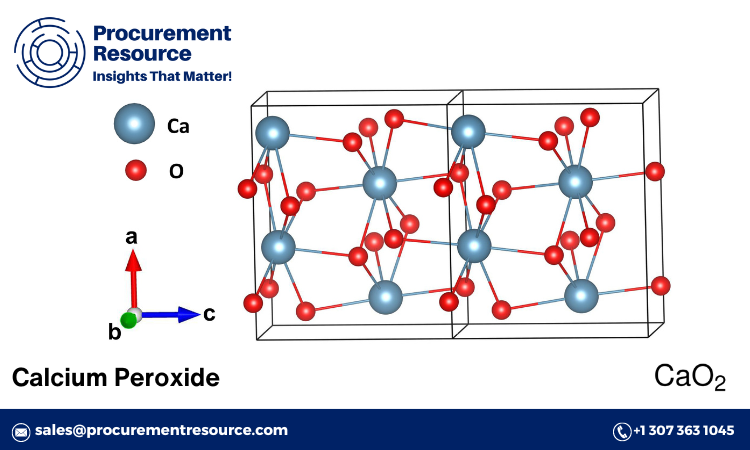
Calcium peroxide (CaO2) is a versatile chemical compound widely used in various industries due to its strong oxidizing properties. It finds applications in environmental remediation, agriculture, and the food industry, among others. The production of calcium peroxide involves a series of chemical reactions and processes designed to ensure high purity and efficiency. This blog provides an in-depth look at the production process, raw material costs, and the latest news in the industry.
Manufacturing Report and Process
Overview of the Production Process
The production of calcium peroxide typically involves the reaction of hydrogen peroxide (H2O2) with calcium hydroxide (Ca(OH)2) or quicklime (CaO). The process can be outlined in several key steps:
Request For Sample: https://www.procurementresource.com/production-cost-report-store/calcium-peroxide/request-sample
- Preparation of Reactants: The first step involves the preparation of the necessary reactants. Hydrogen peroxide is often obtained in a concentrated form, while calcium hydroxide or quicklime is prepared from natural sources of calcium carbonate through calcination.
- Reaction Process: The main chemical reaction occurs when hydrogen peroxide is mixed with calcium hydroxide or quicklime.
- Filtration and Drying: The resulting calcium peroxide is filtered to remove any impurities and then dried to achieve the desired moisture content.
- Crushing and Milling: The dried calcium peroxide is then crushed and milled to obtain a fine powder, which enhances its usability in various applications.
- Packaging: The final product is packaged in suitable containers to protect it from moisture and other environmental factors that could degrade its quality.
Quality Control
Quality control is a critical aspect of the calcium peroxide production process. Various tests are conducted to ensure the purity and efficacy of the final product. These tests include:
- Purity Analysis: Measuring the concentration of calcium peroxide to ensure it meets industry standards.
- Moisture Content: Ensuring the moisture content is within acceptable limits to prevent premature decomposition.
- Particle Size Distribution: Analyzing the particle size to ensure it is suitable for the intended applications.
Raw Material Costs
The cost of raw materials plays a significant role in the overall production cost of calcium peroxide. The primary raw materials include hydrogen peroxide and calcium hydroxide or quicklime. Here is an overview of their costs:
Hydrogen Peroxide
Hydrogen peroxide is a key reactant in the production of calcium peroxide. Its cost can vary depending on factors such as concentration, purity, and market demand. Generally, hydrogen peroxide is available in concentrations ranging from 30% to 70%. The cost per kilogram can vary, but as of recent market trends, it ranges from $0.50 to $2.00 per kilogram.
Calcium Hydroxide and Quicklime
Calcium hydroxide and quicklime are derived from natural sources of calcium carbonate, such as limestone. The cost of these materials is influenced by mining and processing expenses. Typically, calcium hydroxide costs around $0.10 to $0.30 per kilogram, while quicklime can range from $0.05 to $0.25 per kilogram.
Other Costs
In addition to the raw materials, other costs associated with the production of calcium peroxide include energy consumption, labor, equipment maintenance, and packaging. These costs can vary based on the scale of production and the efficiency of the manufacturing process.
Latest News
Innovations in Production Techniques
The calcium peroxide industry is witnessing several innovations aimed at improving the efficiency and sustainability of the production process. Researchers are exploring new methods to enhance the yield and purity of calcium peroxide while minimizing environmental impact. One such innovation involves the use of green chemistry principles to reduce the use of hazardous chemicals and optimize energy consumption.
Market Trends and Demand
The demand for calcium peroxide is on the rise, driven by its increasing applications in various industries. In the environmental sector, calcium peroxide is used for soil and groundwater remediation due to its ability to release oxygen and break down contaminants. In agriculture, it is employed as a soil conditioner and seed treatment agent. The food industry utilizes calcium peroxide as a flour bleaching agent and dough conditioner. This growing demand is expected to drive market growth and create new opportunities for manufacturers.
Regulatory Developments
Regulatory bodies are continuously updating guidelines and standards related to the production and use of calcium peroxide. These regulations aim to ensure the safety and efficacy of the compound while minimizing its environmental impact. Manufacturers must stay informed about these developments to remain compliant and competitive in the market.
Partnerships and Collaborations
Collaborations between research institutions, industry players, and government agencies are fostering advancements in calcium peroxide production. These partnerships aim to share knowledge, resources, and expertise to address challenges and explore new applications. For instance, joint ventures are being established to develop more efficient production methods and expand the use of calcium peroxide in emerging markets.
Sustainability Initiatives
Sustainability is a key focus area for the calcium peroxide industry. Manufacturers are implementing measures to reduce their carbon footprint, optimize resource utilization, and minimize waste generation. This includes adopting renewable energy sources, improving process efficiency, and recycling by-products. These initiatives not only enhance the environmental performance of the industry but also contribute to cost savings and operational efficiency.
Conclusion
The production of calcium peroxide is a complex and dynamic process that requires careful consideration of various factors, including raw material costs, production techniques, and market trends. Staying informed about the latest developments and innovations in the industry is crucial for manufacturers to maintain a competitive edge. As demand for calcium peroxide continues to grow across different sectors, the industry is poised for significant advancements and opportunities in the coming years.






